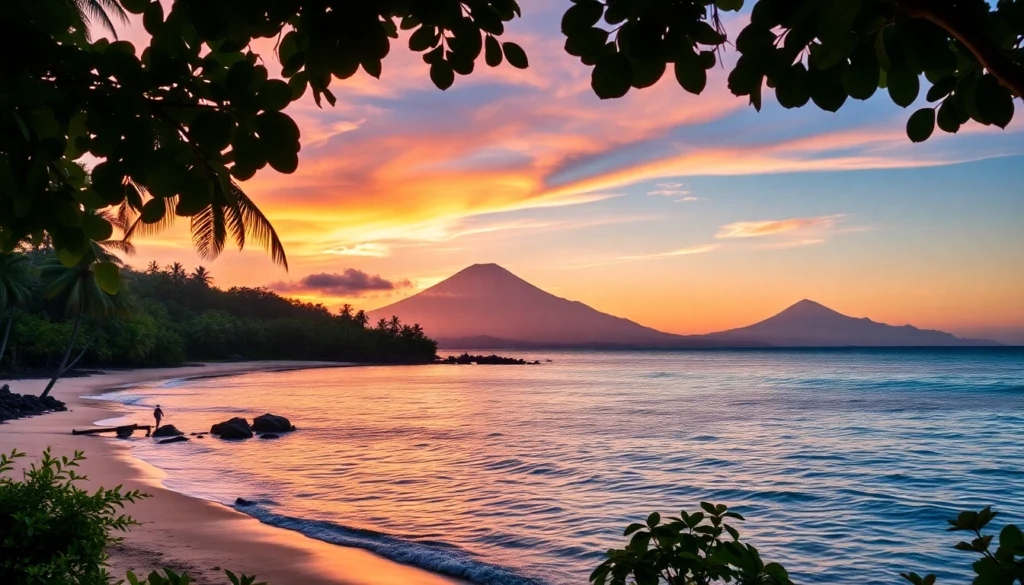
Getting to Know Lombok
As one of Indonesia’s most captivating islands, Lombok offers a rich blend of natural beauty, cultural heritage, and adventure. Situated in the West Nusa Tenggara province, Lombok stands as a vibrant destination that attracts travelers seeking pristine beaches, towering volcanoes, and authentic local experiences. Understanding Lombok’s geographic, historical, and administrative context is essential for both prospective visitors and those interested in its development and sustainability.
Geographic Location and Regional Overview
Lombok is part of the Lesser Sunda Islands chain, positioned just east of Bali and separated by the Lombok Strait. Covering approximately 4,738 square kilometers, the island boasts diverse landscapes ranging from lush rainforests and terraced rice paddies to dramatic coastlines and volcanic mountain ranges. Its strategic location offers proximity to popular travel hubs, with the Lombok International Airport serving as a primary gateway. The island is administratively divided into several regions, including Lombok Barat (West Lombok), Lombok Tengah (Central Lombok), and Lombok Utara (North Lombok), each with unique attractions and community structures.
Additionally, Lombok is surrounded by smaller islands and coral reefs, notably the Gili Islands—Gili Trawangan, Gili Meno, and Gili Air—which are renowned for their marine biodiversity and vibrant nightlife. The island’s geographical positioning contributes to its favorable tropical climate, characterized by warm temperatures year-round and distinct wet and dry seasons, making it a year-round destination for tourists.
Historical and Cultural Background
Historically, Lombok has been a crossroads of indigenous cultures and external influences, primarily from India, Arabia, and later, European traders. The island’s indigenous Sasak people have maintained a vibrant cultural identity characterized by unique traditions, language, and craftsmanship. Their ancient practices are reflected in their architecture, textiles, and rituals which continue to thrive amid modern influences.
The spread of Islam in Lombok occurred over centuries, blending with existing animist beliefs to form a distinctive spiritual landscape. Colonial history, especially Portuguese and Dutch incursions in the 17th and 19th centuries, also left their mark, including architectural remnants and colonial administration infrastructure. Post-independence, Lombok has rapidly developed, balancing growth with the preservation of its cultural heritage—evident in traditional villages, ceremonies, and arts that remain central to community life.
Today, cultural festivals such as Bau Nyale, celebrating the sea worms that symbolize prosperity, and various Sasak arts exhibitions, serve as vital links to Lombok’s rich history and ongoing cultural renaissance. Recognizing and respecting these traditions enhances the visitor experience and supports sustainable tourism development.
Major Cities and Administrative Divisions
The administrative landscape of Lombok features several key regions that function as centers of governance, commerce, and culture. The main cities include:
- Mataram: The provincial capital and largest urban area on Lombok, Mataram serves as the economic and administrative hub, featuring markets, government offices, and educational institutions.
- Lombok Tengah (Central Lombok): Known for its agricultural significance and access to Mount Rinjani, this region also hosts popular tourist routes and traditional villages.
- Lombok Barat (West Lombok): A coastal region famed for its pristine beaches, surfing, and the colonial-era Senggigi Beach resort area.
- Lombok Utara (North Lombok): Home to Mount Rinjani and scenic coastal landscapes, it’s a hub for eco-tourism and adventures such as mountain trekking and diving.
Understanding these divisions helps travelers navigate the island more effectively, whether planning for accommodation, transportation, or exploring regional attractions.
Natural Attractions and Landmarks in Lombok
Gunung Rinjani: The Iconic Volcano
Standing at approximately 3,726 meters, Gunung Rinjani is Indonesia’s second-highest volcano and a symbol of Lombok’s rugged beauty. Its caldera houses a stunning crater lake, Segara Anak, which is stunningly blue and often shrouded in mist, offering spectacular photographic moments. Rinjani is a magnet for trekkers worldwide, with routes varying from easy hikes to challenging multi-day expeditions.
Successful ascent requires proper preparation, including acclimatization to high altitude, adequate gear, and local guides to ensure safety. The journey provides awe-inspiring vistas, geothermal features, and encounters with endemic flora and fauna. Rinjani’s volcanic activity and geological features also serve as a natural laboratory for scientists and adventure enthusiasts alike.
Pantai Kuta and White Sand Beaches
Lombok’s southern coast showcases some of Indonesia’s most stunning beaches, with Pantai Kuta leading the way. Known for its expansive white sands and turquoise waters, Kuta Beach is a hotspot for surfers, especially during the peak seasons, when the surf waves attract both beginners and seasoned surfers.
Beyond surfing, the beach area offers laid-back resorts, beachfront cafes, and vibrant night markets. The region’s natural beauty extends to nearby beaches like Tanjung Aan, renowned for their pristine sands and excellent swimming conditions, making Lombok a perfect destination for sunbathers and water sports lovers alike.
Gili Islands and Marine Biodiversity
The Gili Islands—Gili Trawangan, Gili Meno, and Gili Air—are among the most popular destinations off Lombok’s coast. These coral fringed islands are celebrated for their crystal-clear waters, vibrant coral reefs, and rich marine life, including manta rays, turtles, and myriad fish species.
Activities such as snorkeling, scuba diving, and island-hopping tours are top priorities for visitors. Gili Trawangan is known for its lively nightlife, while Gili Meno and Gili Air offer tranquility and intimacy for a more relaxed experience. The sustainable management of these reefs and island ecosystems is crucial to maintaining their ecological health and attractiveness.
Unique Cultural Experiences on Lombok
Traditional Sasak Villages and Crafts
The Sasak people are the indigenous inhabitants of Lombok, characterized by their distinctive language, dress, and crafts. Visitors can explore traditional villages such as Sade and Ende, where they observe weaving, pottery, and woodcarving techniques passed down through generations. These villages provide authentic insights into Sasak daily life, social structures, and spiritual practices.
Participating in craft workshops or purchasing handmade souvenirs supports local artisans and promotes cultural preservation. Recognizing the significance of these crafts enhances visitor engagement and fosters sustainable tourism practices that empower local communities.
Festivals and Local Celebrations
Lombok’s vibrant festivals often coincide with agricultural cycles, religious holidays, and cultural rites. The Bau Nyale Festival, for example, draws thousands annually to witness the sea worm hunting tradition, symbolizing fertility and prosperity. Other celebrations include Pockara (Sasak New Year), and various Islamic festivals, bringing communities together in prayer, dance, and feasting.
Engaging respectfully with these festivals offers tourists a deeper understanding of Lombok’s spiritual and communal life. Supporting local events contributes to cultural sustainability and supports the economy of artisan and performance groups.
Arts, Music, and Dance Traditions
Lombok boasts a rich artistic scene rooted in traditional Sasak music, dance, and crafts. Gendang (drum) performances and traditional dance dramas depict stories from folklore, history, and religion. Arts such as Ikat weaving, batik textiles, and wood carvings are highly valued and serve as expressions of cultural identity.
Many villages host regular cultural shows, workshops, or art exhibitions, providing immersive experiences for visitors. Promoting these traditions strengthens community pride and ensures their transmission to future generations.
Adventure and Eco-tourism Activities
Hiking, Trekking, and Mount Rinjani Expeditions
Beyond the summit, Lombok offers numerous hiking trails through rice terraces, waterfalls, and forests. The trek to Rinjani’s crater rim is world-renowned, supporting a growing eco-tourism sector. Proper planning, seasoned guides, and sustainable practices are essential to minimize environmental impact and maximize safety.
Additional trails in areas like Senaru and Sembalun offer moderate hikes, scenic viewpoints, and access to waterfalls like Sendang Gile and Tiu Kelep—treasures for nature lovers and adventure travelers.
Water Sports and Snorkeling in Coral Reefs
With its warm waters and vibrant coral reefs, Lombok ranks among top surfing and snorkeling destinations. Surf spots such as Gerupuk and Eko’s Beach catering to all skill levels. Snorkelers can explore rich marine ecosystems near the Gili Islands and coastlines like Pantai Tanjung Aan and Senggigi.
Implementing eco-friendly practices, like reef-safe sunscreens and responsible diving, ensures the longevity of these delicate habitats. Local operators often promote sustainable tourism standards, making adventure activities environmentally conscious.
Ecotourism and Sustainable Travel Initiatives
Lombok has increasingly adopted eco-tourism approaches, promoting conservation, community involvement, and responsible travel. Initiatives include community-managed conservation areas, eco-lodges, and educational programs aimed at reducing environmental footprints.
Visitors are encouraged to participate in activities such as beach clean-ups, supporting local eco-friendly businesses, and respecting cultural sites. These efforts are vital for maintaining Lombok’s natural and cultural integrity amidst growing tourism pressures.
Travel Tips and Practical Guides for Visitors
Best Time to Visit and Climate Insights
The optimal period to visit Lombok is during the dry season, from May to September, when weather conditions are ideal for outdoor activities, beach lounging, and mountain trekking. The rainy season, from November to March, can be challenging due to frequent downpours but offers lush landscapes and fewer crowds.
Understanding local weather patterns, vehicle conditions, and seasonal festivals helps travelers plan effectively and maximize their experience.
Local Cuisine and Dining Experiences
Lombok’s cuisine reflects its cultural diversity, with signature dishes such as Ayam Taliwang (spicy grilled chicken), Plecing Kangkung (water spinach with chili sauce), and various seafood specialties. Traditional markets and warungs (local eateries) provide authentic flavors at affordable prices, while upscale restaurants offer modern twists on local dishes.
Sampling Lombok’s food is an integral part of the cultural experience, and engaging with local cooks can add depth to your culinary journey.
Visa, Accommodation, and Transportation Tips
Most travelers to Lombok from abroad require a visa, which can often be obtained on arrival or in advance. Accommodation options range from luxury resorts and boutique hotels to budget hostels and homestays, catering to every travel style and budget.
Getting around the island is facilitated by rental cars, motorcycles, and local transports such as shuttle buses and taxis. Planning routes carefully and securing reliable transportation ensures a smooth journey across diverse terrains, from mountainous roads to coastal highways.



